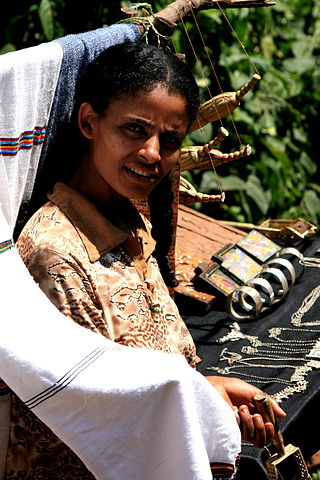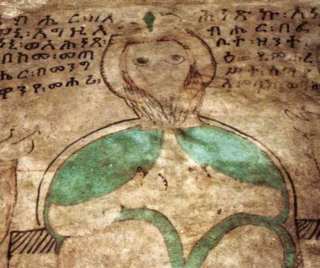Related Research Articles

Amharas are a Semitic-speaking ethnic group which is indigenous to Ethiopia, traditionally inhabiting parts of the northwest Highlands of Ethiopia, particularly inhabiting the Amhara Region. According to the 2007 national census, Amharas numbered 19,867,817 individuals, comprising 26.9% of Ethiopia's population, and they are mostly Oriental Orthodox Christian.

Shewa, formerly romanized as Shua, Shoa, Showa, Shuwa, is a historical region of Ethiopia which was formerly an autonomous kingdom within the Ethiopian Empire. The modern Ethiopian capital Addis Ababa is located at its center.

Abune Tekle Haymanot was an Ethiopian saint and monk mostly venerated as a hermit. He was the Abuna of Ethiopia who founded a major monastery in his native province of Shewa. He is significant for being the only Ethiopian saint popular both amongst Ethiopians and outside that country. Tekle Haymanot "is the only Ethiopian saint celebrated officially in foreign churches such as Rome and Egypt." His feast day is 30 August, and the 24th day of every month in the Ethiopian calendar is dedicated to Tekle Haymanot.

Yohannes IV was Emperor of Ethiopia from 1871 to his death in 1889 at the Battle of Gallabat, and king of Tigray from 1869 to 1871. During his reign he successfully defended Ethiopia against a large-scale Egyptian invasion.

Wollo was a historical province of northern Ethiopia. During the Middle Ages this province name was Bete Amhara and it was the centre of the Solomonic emperors. Bete Amhara had an illustrious place in Ethiopian political and cultural history. It was the center of the Solomonic Dynasty established by Emperor Yekuno Amlak around Lake Hayq in 1270. Bete Amhara was bounded on the west by the Abbay, on the south by the river Wanchet, on the north by the Bashilo River and on the east by the Escarpment that separate it from the Afar Desert.

Yekuno Amlak ; throne name Tesfa Iyasus was Emperor of Ethiopia, from 1270 to 1285, and the founder of the Solomonic dynasty, which lasted until 1974. He was a ruler from Bete Amhara who became the Emperor of Ethiopia following the defeat of the last Zagwe king.

Debre Libanos is an Ethiopian Orthodox Tewahedo monastery, lying northwest of Addis Ababa in the North Shewa Zone of the Oromia Region. It was founded in 1284 by Saint Tekle Haymanot as Debre Atsbo and was renamed as Debre Libanos in the 15th century. He meditated in a cave above the current monastery for 29 years. The monastery's chief abbot, called the Ichege, was the second most powerful official in the Ethiopian Church after the Abuna.

Lake Hayq is a freshwater lake of Ethiopia. It is located north of Dessie, in the Debub Wollo Zone of the Amhara Region. The town of Hayq is to the west of the lake.
Amha Iyasus Kidane Kale, better known as Ammehayes, was a Meridazmach of Shewa, an important Amhara noble of Ethiopia. He was the son of Kidane Kale, and a sister of Goshu of Amhara.

Darge Sahle Selassie, Horse name Abba Gersa, was a 19th-century Ethiopian nobleman, provincial governor, general and a trusted councillor of his nephew Emperor Menelik II.

The Zemene Mesafint was a period in Ethiopian history between the mid-18th and mid-19th centuries when the country was ruled by a class of Oromo elite noblemen who replaced Habesha nobility in their courts, making the emperor merely a figurehead. For the most part, the regional lords were tightly related by marriage and constituted a stable ruling elite that prevailed until the mid-20th century. In short, during the Zemene Mesafint, the emperors from the Solomonic dynasty were reduced to little more than figureheads confined to the capital city of Gondar.
Fiche is a town in central Ethiopia. It is the administrative centre of the Northern Shewa Zone in Oromia. It's located about three kilometers from the main Addis Ababa-Debre Marqos road, Fiche has a latitude and longitude of 9°48′N38°44′E and an elevation between 2,738 and 2,782 metres above sea level.
Guduru is a woreda in Oromia Region, Ethiopia. This woreda is named after one of the sections of the Macha Oromo, also known as the Torban Guduru, which coalesced into a kingdom around 1855 under Gama Moras, which lay between the Abay River and the Gibe region. It was also the location of the Battle of Embabo, fought 6 June 1882; the Shewan forces of Menelik defeated the Gojjame army, capturing Negus Tekle Haymanot and establishing a Shewan hegemony over the territories south of the Abay.

The Battle of Embabo was fought 6 June 1882, between the Shewan forces of Negus Menelik and the Gojjame forces of Negus Tekle Haymanot. The forces fought to gain control over the Oromo areas south of the Gibe River. The Gojjame forces under Tekle Haymanot were defeated. This is one of the three battles which Donald Donham lists that led to Shewan supremacy over the rest of Ethiopia.

The Kingdom of Damot was a medieval kingdom in what is now western Ethiopia. The territory was positioned below the Blue Nile. It was a powerful state that forced the Sultanate of Showa to pay tributes. It also annihilated the armies of the Zagwe dynasty that were sent to subdue its territory. Damot conquered several Muslim and Christian territories. The Muslim state Showa and the new Christian state under Yekuno Amlak formed an alliance to counter the influence of Damot in the region.

The Jamma River is a river in central Ethiopia and a tributary to the Abay. It drains parts of the Semien Shewa Zones of the Amhara and Oromia Regions. The Upper Jamma flows through steep, deep canyons cut first through volcanic rock and then through the Cretaceous sandstone and shaly sandstone, with Jurassic limestone at the bottom. It has a drainage area of about 15,782 square kilometers in size. Tributaries include the Wanchet.

Tekle Haymanot Tesema, also known as Adal Tesema, Tekle Haymanot of Gojjam, and Tekle Haimanot of Gojjam, was King of Gojjam. He later was an army commander and a member of the nobility of the Ethiopian Empire.
Chercher was a province in Hararghe now part of Oromia Region, Ethiopia. Also known as Ittuu and West Hararghe, Chercher is the name given mainly to the eastern escarpment highland areas of Oromia state's West Hararaghe Zone, where the chains of Checher or higher mountains rise and extend inland from the Great Rift Valley in its northwest. The capital of the former Chercher province was Chiro.
Bulga is a former historical region of Ethiopia in the central part of Shewa. It was bounded by the Germama river to the south, which formed the historical boundary between it and Minjar in the south. It presently encompasses the modern woredas of Hagere Mariamna Kesem, Asagirt, and Berehet.
Damot was a historical region located in western Ethiopia. The region was situated south of Gojjam and covered most of Ethiopia's Welega Province. Until the fourteenth century it was ruled by its own independent kingdom, before its conquest by the Ethiopian Emperor Amda Seyon I, after which it would serve as an important province within the Ethiopian Empire during the medieval period.
References
- ↑ "NIRAS in Ethiopia, October 2011" . Retrieved 10 April 2014.
- ↑ Hassen, Mohammed (2015). The Oromo and the Christian Kingdom of Ethiopia: 1300-1700. Boydell & Brewer. p. 128. ISBN 9781847011176.
- ↑ Phillips, David J. (2001). Peoples on the Move: Introducing the Nomads of the World. William Carey Library. p. 205. ISBN 9780878083527.
- ↑ G.W.B. Huntingford, The Historical Geography of Ethiopia (London: The British Academy, 1989), p. 69
- ↑ "Local history of Ethiopia : Fia - Fyanja" (PDF). Nordic Africa Institute. Retrieved 8 June 2024.
This article needs additional or more specific categories .(June 2022) |